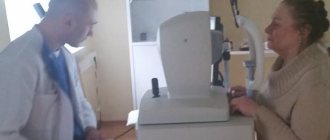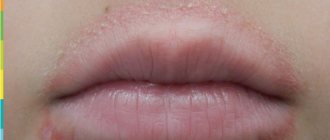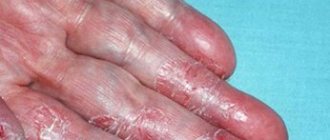In this article we will tell you:
- Causes of chalazion
- Symptoms and diagnosis of chalazion
- Chalazion treatment
- Contraindications
- Complications
- Prevention of chalazion
- Chalazion in children
- Conclusion
A chalazion (or chalazion) is a chronic inflammation of the eyelid margin around the meibomian gland, resulting from a blockage. Externally, chalazion is very similar to stye; both diseases manifest themselves in the form of a small nodule. Unlike styes, chalazions rarely resolve on their own. It has its own signs, symptoms, stages and treatment regimen. There are several types of chalazion. It can be internal (located inside the eyelid) and external. There is a chalazion of the upper eyelid and a chalazion of the lower eyelid. When we are healthy, our sebaceous glands produce fatty secretions. It moisturizes the mucous membrane of the eye, facilitates the movement of the eyelids during blinking. When the meibomian gland ducts are blocked, a chalazion can develop. Most often, the pathology occurs in people over 30 years of age. Chalazion does not threaten human life. In addition to pain, it most often causes only cosmetic discomfort.
Causes of chalazion
- Chalazion on the eyelids develops as a pathological process. It can be triggered by various factors:
- Unsanitary conditions in the premises, poor hygiene;
- Weakened immune system;
- Incorrect use of contact lenses;
- Stress, depression, disturbed psycho-emotional state;
- Hypothermia of the body;
- Vitamin deficiency as a consequence of improper diet;
- Untreated barley;
- Excess cosmetics on eyelids and eyelashes. For example, upper eyelid chalazion can occur in women who wear false eyelashes;
- Chronic forms of blepharitis;
- Skin diseases;
- Oncology;
- Hormonal imbalances and metabolic disorders, including diabetes;
- Blockage of the excretory ducts of the meibomian glands
Wen under the eyes - causes of appearance
There are several reasons for the appearance of wen under the eyes. The most common problems in the functioning of the body are:
- disorders of fat metabolism (accumulation of sebum, increased viscosity or decreased outflow);
- elevated cholesterol levels;
- diseases of the gastrointestinal tract, liver;
- hormonal imbalances.
Rice. 2. Wen above and under the eyes - atheromas
In addition to problems within the body, there are external provoking factors. This may include the environment, cuts and injuries, infections in the upper layer of the epidermis, and improper facial skin care. Quite often, the appearance of small nodules in the eye area is caused by the active use of cosmetics - when a girl wears makeup for days, not allowing her face to rest. The use of low-quality cosmetics or improper hygiene also leads to the appearance of wen under the eyes. Another provoking factor is an incorrect diet (fatty, smoked or too sweet foods). All problems with the skin and face begin with malfunctions in the gastrointestinal tract and liver. This is why you should be responsible about your lifestyle and diet.
Rice. 3. Wen above galaz - atheroma
Symptoms and diagnosis of chalazion
Typically, the inflammatory process begins smoothly and gradually becomes chronic. A person discovers lumps by accident. Both diseases present in the same way with redness and swelling of the eyelid. Barley occurs due to purulent inflammation of the gland tissue, while chalazion is the result of a blocked duct. It affects the inside of the eyelid and is in close contact with the conjunctiva of the eye. But pathology can develop precisely because of untreated barley.
Styes, as a precursor to chalazion, can be caused by a bacterial infection. In most cases it is Staphylococcus aureus. Bacteria begin to multiply due to weakened immunity and colds. It is important to catch the onset of the inflammatory process at an early stage in order to prevent its development.
The following diagnostic procedures may be required:
- General blood analysis;
- Bacteriological blood culture;
- Screening immunogram;
- Stool analysis;
- Staphylococcus culture;
- Analysis of sexually transmitted infections.
Inflammation can develop due to:
- Bacteria;
- Gribov;
- Parasites;
- Chlamydia;
- Viruses.
There are a number of signs that will help determine that barley is developing into a chalazion:
- After a week of treatment for stye, it does not decrease and the redness does not subside;
- Increases in size, begins to bleed and affects vision;
- The eyelid area becomes red and swollen;
- Redness may appear on the cheeks or other parts of the face.
If any of the signs occur, consult a doctor immediately. You may have a chalazion.
The clinical picture of chalazion formation is as follows:
- A lump grows on the eyelid;
- There is slight pain, swelling, and the mucous membrane of the eye turns red;
- The tumor becomes mobile and looks like a small pea.
If you let the process take its course, then:
- Visual acuity is impaired;
- The cone increases to 1 cm in diameter;
- The temperature may rise, lacrimation may increase, and itching in the eyelid area may appear.
When the formation develops into a cyst, it accumulates pus and spontaneously opens. If you do not seek help from a specialist, pus remaining under the eyelid can cause new lumps to appear. Inflammation can be easily avoided if chalazion treatment is started in the early stages.
Typically, an ophthalmologist recognizes the disease by external examination of the inflamed eyelid. If the disease affects the upper eyelid, the doctor turns it inside out to see the lump. As a rule, local swelling of the conjunctiva is observed. When a lesion is present, blink rate may decrease. If there is a suspicion of a malignant tumor, the ophthalmologist prescribes a histological examination. Often additional examination methods are required when a diagnosis has already been established. These include blood, urine and stool tests, cultures for staphylococcal infections, enzyme-linked immunosorbent assays and screening immunograms, and tests for sexually transmitted infections. The ophthalmologist may additionally prescribe a consultation with an immunologist, dermatologist and parasitologist.
WHAT DO BAGS UNDER THE EYES TELL US?
You can be well-slept and rested, but if a person has bags under his eyes, he will still look tired and sick.
It would seem that the problem is not serious. However, bags under the eyes can signal significant health problems. Most often, swelling under the eyes is considered a sign of kidney disease, but this is not always true. There are many reasons for swelling under the eyes.
Kidney diseases
Kidney diseases are the first to be suspected, and this is no coincidence. The fact is that with serious pathologies (glomerulonephritis, severe stage of pyelonephritis, kidney tumors) protein is lost.
“With urine, the body loses a huge amount of large molecular protein compounds. That is, the kidney filter, which normally does not allow large compounds to exit with urine and retains them in the bloodstream, collapses, explains nephrologist at the Aflo-Center medical clinic network, Irina Anatolyevna Kotryakhova. “Low levels of protein in the blood cause some of the fluid to leak into the tissues.”
Renal edema usually does not occur without a large amount of protein in the urine.
Even doctors at district clinics sometimes get lost in determining whether there is “a lot or a little protein in the urine.” It happens that after medical examination the patient is urgently referred to a urologist or nephrologist to treat renal pathology. In fact, protein can be lost in small quantities for completely natural reasons. For example, if on the eve of the tests a person worked out hard in the gym. “If the daily loss of protein exceeds 3 grams per liter (this is very much) and swelling occurs, which is most pronounced in the morning, this is the kidneys. Such patients are sent to the hands of nephrologists,” says Irina Kotryakhova about the intricacies of diagnosis.
Urological patients can be seen immediately. Their face is swollen like a ball. Most often, a morning puffy look has nothing to do with kidney disease. Especially when it comes to women over 30 years old.
“As practice shows, 8 out of 10 young and middle-aged patients who complain of “bags” under their eyes are patients of plastic surgeons,” concludes Yuri Vladimirovich Goloviznin, a urologist at the Aflo-Center medical clinic network.
Heart problems
If, in addition to “bags” under the eyes, the patient is bothered by chest pain, rapid heartbeat, shortness of breath and swelling of the legs, the cause may be cardiovascular pathology. An ECG will show it first.
“In heart failure, swelling first appears in the feet and legs. If proper treatment is not carried out, they will rise higher and we will see “bags” under the eyes. But these “bags” are of a completely different kind, and not the swelling of the eyelids that we are used to seeing after sleep, explains Anton Ryabov, a cardiologist-arrhythmologist at the Aflo-Center medical clinic network. — Edema itself is not a symptom of cardiac disease. Therefore, self-diagnosis based only on “bags” under the eyes is strange, to say the least. Better yet, get some sleep. Perhaps the swelling will go away.”
Aging
A little theory. The eyeball is separated from the orbit by adipose tissue - periorbital tissue, which is held in place by a connecting membrane - the orbital septum. With age, the volume of periorbital fiber increases (for some, more, for others, less). The septum cannot withstand the pressure, and the fatty tissue extends beyond the eye sockets. Genetic predisposition plays an important role in this case.
As Igor Popov, an ophthalmologist at the Aflo-Center medical clinic network, explains, the majority of those who observe unflattering “bags” are candidates for blepharoplasty. All kinds of creams that promise instant results will not help reduce the volume of periorbital tissue.
Liver diseases
Unlike “bags,” bruises are associated precisely with a decrease in subcutaneous fat. Due to lack of sleep or sudden weight loss, the eyeballs literally fall into their sockets. This is a common and non-threatening condition. According to Zhanna Krupina, a gastroenterologist at the Aflo-Center medical clinic network, “unnatural” brownish-yellow shades should alert you. Coupled with swelling of the hands (especially fingers), heartburn, nausea and pain in the right hypochondrium, a shadow cast under the eyes may indicate liver pathology.
Edema
There are more obvious reasons for the appearance of bags under the eyes, and, as a rule, they do not go unnoticed. As Nadezhda Shubina, an allergist-immunologist at the Aflo-Center medical clinic network, explained, allergic diseases of the conjunctiva, inflammatory diseases of the paranasal sinuses, ARVI - all conditions in most cases are manifested by edema. Not to mention chronic fatigue and a severe hangover - everything is clear here.
It is important to remember: physiological “bags” under the eyes as a result of swelling are “conspicuous” after sleep and gradually fade away by the end of the day.
Pathological growth of fatty tissue does not depend on the time of day. Such “bags” do not go away after a long rest and practically cannot be corrected at home or in cosmetologist’s offices. Much less often, swelling of the eyelids is a signal of serious pathologies. But in beauty salons it is not customary to talk about this.
Drug-induced edema
Some medications also cause fluid retention in the body; most often, patients complain of side effects from oral contraceptives.
Combined hormonal contraceptives are based on two female hormones - estrogen and progesterone. The amount of estrogen is almost always the same, the only differences are in the amount of progesterone. Each patient reacts to this proportion differently.
“Differences in progesterone levels are reflected in subjective sensations. Then we select a drug with a different composition for the patient, which reduces the accumulation of fluid in the body,” says Valentina Smirnova, a gynecologist at the Aflo-Center medical clinic network.
Allergic reactions
Allergic swelling comes with the onset of spring and is usually accompanied by itching and redness. Those who have encountered this problem will not confuse such “bags” with anything else.
Thyroid diseases
Another cause of edema, according to Tatyana Sokolova, an endocrinologist at the Aflo-Center medical clinic network, is hypothyroidism. In this case, swelling appears not only under the eyes, but also on the legs, arms, and there may be swelling of the internal organs. Problems with the thyroid gland are accompanied by a number of other symptoms, and “bags” only confirm the diagnosis.
And in conclusion
In any case, you should take care of your eye health and consult a doctor at the first alarming symptoms.
In the Aflo-Center network of medical clinics, you can undergo a comprehensive examination, carry out the necessary diagnostics and treatment of existing diseases.
Make an appointment with a doctor by phone: (8332) 497-003,
Electronic registration: online.afflow.ru
Chalazion treatment
In the early stages of the disease, the doctor will tell you how to treat chalazion and prescribe conservative treatment. It includes the use of antibacterial drops, ointments, and dry warm compresses on the eyelid area. To remove viscous lipid secretions, you can use eyelid massage.
Massage is effective only at the initial stage of the disease. It must be performed exclusively in circular movements and with extreme caution. Contact your doctor to go through the procedure with you several times. He will demonstrate the force of pressure to massage the inflamed area. Do not resort to traditional methods of treatment. The eyes react sharply to any irritants. When the mucous membrane is irritated, it can cause multiple inflammations, and it will be difficult to cure the disease without surgery.
If the size of a pea does not exceed 4 mm, the doctor prescribes herbal medicine and physiotherapy: electrophoresis, laser heating, UHF. When such treatment does not help, the doctor uses steroid hormonal drugs to promote the resorption of the chalazion.
If the pathological process has gone far, visual function is impaired or relapses occur, you will have to consult a surgeon for treatment of chalazion. Eyelid surgery is indicated for nodule sizes greater than 5 mm. The surgeon opens the nodule and scrapes out its cavity. To reduce pain and avoid relapses, the doctor often operates with a laser. Removing a chalazion of the upper or lower eyelid takes about half an hour and is performed on an outpatient basis under local anesthesia. In the postoperative period, it is recommended to put an eye ointment with an antibiotic behind the eyelid. It is advisable to visit a doctor in a week for a re-examination. In the first days after surgery, the skin around the operated eye may be swollen and hyperemic, however, soon all unpleasant symptoms disappear.
The treatment time depends on the individual characteristics of the body and the course of the disease. If there are no complications, 1 or 2 weeks will be enough. If the process is started, therapy can last up to 8 weeks.
The application of cosmetics, especially to the mucous membrane of the eyes, will have to be limited to up to 1 month. Creams, lotions, masks, patches and tonics should also be put aside. If you apply cosmetics during the treatment period, this will aggravate the inflammation, increase the redness of the area around the chalazion, and it will increase in size. Exposure to the eyes should be kept to a minimum in the future to prevent recurrence of the disease.
Types of wen on the eyelids
Wen on the eyelids are classified according to their location. It could be:
- Wen on the upper eyelid is the most common formation, usually small in size. It creates the most inconvenience, since the wen hanging on the upper eyelid interferes with vision.
- Wen on the inner eyelid is a rare benign formation. If it appears, you should immediately consult a doctor.
- Wen on the lower eyelid is quite common. It causes discomfort and gives the eyes an unaesthetic appearance.
Complications
By delaying treatment, you risk developing a chalazion. A secondary infection may occur, and the disease progresses to the stage of abscess chalazion. Swelling appears on the skin around the entire area of inflammation. A situation may arise in which a channel connecting them (fistula) is formed between the cavity of the chalazion capsule and the skin of the eyelid. After which the chalazion spontaneously opens and the purulent contents flow out through the fistula. With this development of events, the patient will certainly require surgical intervention, since the abscess can renew in the remaining dense pyogenic capsule (otherwise known as the purulent membrane). Another complication is that chalazion puts constant pressure on the eyeball, thereby irritating it and leading to the development of conjunctivitis in the patient.
There is a possibility of complications after surgery to remove a chalazion. If the capsule is not completely removed or the wound is not thoroughly inspected, the blockage may occur again. If the specialist’s recommendations are ignored, the level of vision may sharply decrease, resulting in astigmatism. In rare cases, keratitis occurs - inflammation of the cornea of the eye, in which it becomes cloudy and the eye turns red, pain also appears, or a cyst with purulent fluid forms.
Prevention of chalazion
Prevention of chalazion includes:
- Proper nutrition;
- Maintaining personal hygiene;
- Strengthening immunity;
- Compliance with the terms of wearing lenses and timely replacement of the solution for their storage;
- Timely treatment of tonsillitis and caries;
- Maintaining a sleep schedule;
- Getting rid of bad habits (smoking, alcohol);
- Eyelid massage.
Also, to prevent chalazion, girls should pay special attention to cosmetic procedures. Before getting eyelash extensions or eyelid tattooing, consult an ophthalmologist.
Chalazion in children
Chalazion is rare in children unless there is a congenital predisposition. The composition of fat secretion is different for everyone, as are the properties of the skin. If you have a predisposition to eye diseases and gland blockage, then there is a high probability that your child may inherit this feature.
Children aged 5 to 10 years are at risk. The difficulty is that the child is inattentive to eye hygiene. Pay attention if your child rubs his eyes frequently. Find out if he is bothered by itching or burning.
Treatment of chalazion in children is no different from treatment in adults. The only difference is that surgery cannot be performed using a laser if the child is under 14 years old.
Wen on the eyelid: how to get rid of it with the help of medications
Treatment of a wen on the eyelid can be carried out using medication. In this case, specialists (often ophthalmologists) give injections to patients, giving them medications that promote the resorption of the lipoma.
Treatment with medications is prescribed if the wen is small in size. Often the effect of the procedures is noticeable after at least 2 months. If such treatment does not help, the wen should be removed surgically or using a laser.
It is worth noting that wen on the eyelid that is not treated in a timely manner can cause discomfort and impair vision. In some cases, lipoma can develop into malignant tumors.








